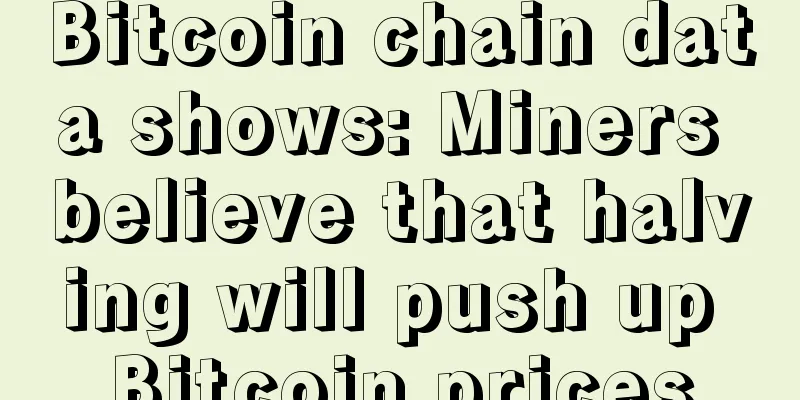Bitcoin chain data shows: Miners believe that halving will push up Bitcoin prices

|
As the coronavirus pandemic continues to spread and new signs of lockdowns in Europe begin to lift, all eyes in the crypto community are on the Bitcoin halving. With the halving just 10 days away, the price of Bitcoin seemed to be on track to follow it earlier this week, rising an incredible 23% to a high of over $9,400 for the month. The Bitcoin halving is a well-known event in the cryptocurrency industry and is part of Bitcoin's monetary policy, in which the Bitcoin mining reward will be cut in half every four years. This means that on May 11, 6.25 new Bitcoins will be issued every 10 minutes instead of the current 12.5. The upcoming halving will be the third since Bitcoin’s inception, and the event brings with it some bullish views on Bitcoin’s value. According to PlanB, the creator of the much-discussed Stock to Flow (S2F) model, a decline in Bitcoin issuance is bound to push up Bitcoin prices in the long run. The analyst recently said in a tweet: “In my opinion, the 2020 Bitcoin halving will be similar to 2012 and 2016. Following the S2F model, I expect a 10x (order of magnitude, not exact) price increase 1-2 years after the halving. For the S2F model, the halving will be a make or break. I hope this halving will teach us more about fundamentals and network effects.” However, opinions vary on the price trend after the halving. Some believe that it will undoubtedly lead to higher prices, while others believe that this factor is already reflected in the current price as it is common knowledge. Other investors ignore the importance of miners and reward distribution because they firmly believe that speculation is the only driver of Bitcoin prices. Bitcoin mining activity worth watching Although speculation is the driving force of Bitcoin's price during bull or bear cycles, supply and demand always play a role. Miners are very important when it comes to understanding Bitcoin's price because they are the only suppliers of new Bitcoins to the market. Miners cash out their newly mined bitcoins to pay for electricity and hosting fees, creating constant selling pressure. While traders take advantage of short-term volatility, miners ultimately "determine" the price of bitcoin in terms of supply. Of course, this is not as linear a relationship as it sounds. Volatility will also determine which miners can stay on the network, and if the price drops too low, some miners may go bankrupt because their business is no longer profitable. A good example of this is the infamous March price crash. Miners are not the only market participants generating selling pressure, but much of the volume on exchanges does not represent actual buying or selling pressure, but rather short-term actions by traders repeatedly buying and selling. Therefore, miners are the only actors that exert sustained selling pressure on newly mined Bitcoin. With this in mind, it is important to understand how miners behave during halvings, as their actions can say a lot about the direction of Bitcoin’s price post-halving. When miners move Bitcoin, the market moves By analyzing certain transaction graphs on the Bitcoin blockchain, it is possible to infer information that can complement trading strategies. For example, Joe Nemelka, a data analyst at on-chain data firm CryptoQuant, recently told Cointelegraph: Percentage of miners flowing into exchanges Source: CryptoQuant Miners liquidate their Bitcoin holdings for a variety of reasons, and tracking this data along with investor sentiment can be valuable for spotting discrepancies and subtle trend changes. For example, during a bull market, when an abnormally high percentage of exchange inflows come from miners, miners may profit and increase selling pressure at price levels they see fit. Conversely, large inflows during a price drop could indicate that a large portion of mining activity is capitulating. This process could signal a change in the market as more resilient miners hold onto Bitcoin and subsequently reduce selling pressure. What are miners doing? The Miner Flow to Exchange Percentage dataset allows market participants to spot spikes in miner selling pressure, while the Miner Position Index allows us to understand the trends in how they are holding or selling Bitcoin. Miner Position Index Source: CryptoQuant The above chart shows that miners have been holding onto Bitcoin since January, likely hoping to sell it at post-halving prices. Mason Jang, chief strategy officer at CryptoQuant, told Cointelegraph: “The MPI (Miners Position Index) highlights that the value of Bitcoin outflow from miners on a daily basis has historically been at extremely high or low levels. An MPI value above 2 indicates that most miners are selling Bitcoin. Similarly, if the MPI is less than 0, it means that there is less selling pressure from miners. Hence, this can be a good signal to buy Bitcoin.” Will history repeat itself? Historically, Bitcoin prices have surged after halvings, which is another favorable factor for a sharp rise in prices after the upcoming fork. However, history does not always repeat itself, and while on-chain data may help us understand upcoming events, it is worth noting that the cryptocurrency market has changed dramatically since the last Bitcoin halving in 2016. CryptoCompare’s data also shows that daily trading volume in 2020 is consistently 10 times higher than in 2016. To put this in perspective, total daily Bitcoin trading volume on spot exchanges rarely exceeded $1 billion in 2016. Fast forward to March 13, 2020, and daily spot trading volume on top exchanges hit a record high of $21.6 billion. The total daily spot trading volume increases year by year Source: CryptoCompare The above chart shows how the market has changed compared to previous years. Considering the extremely high volume of Bitcoin in 2020 and the increasing number of market participants, the decline in miner selling pressure could have a huge impact on overall Bitcoin selling pressure. This means that the upcoming halving may not translate into a significant increase in Bitcoin prices. What can we do about it? While the halving has been a historically bullish event for Bitcoin, that doesn’t necessarily mean it will always be that way. On-chain data is a great tool to supplement individual trading and investment strategies, but it should be examined in a broader context. Since the last halving, the market has matured a lot, with new players bringing higher volumes and exchanges being more transparent, reliable, and regulated. In addition, the current coronavirus pandemic has shown that traditional expectations of market behavior can change quickly. |
>>: The "Wu-Zhan War" between Bitmain and James Bond re-emerges
Recommend
What happened to Bitmain yesterday? Series 13 (497 that determines its lifeline?)
What happened to Bitmain yesterday? Zhan's si...
Overstock invests in Belgian blockchain voting startup SettleMint
Rage Comment : t0 is a holding subsidiary of Over...
How to identify people: Moles on the face can help you identify people
How to identify people: Moles on the face can hel...
There are island patterns on the wisdom line of palmistry
There are island patterns on the wisdom line of p...
What kind of women have bad luck? What are women with bad luck like?
Some people are born lucky and extremely happy. T...
Taboos of fortune telling
Taboos of fortune telling Master's Teachings:...
How to analyze a woman's love fortune through her eyes
According to big data, women are generally more e...
What kind of palm is the most miserable?
When you live a life with no worries about food a...
A woman with a triangle pattern on her right hand has good luck in love.
From the perspective of physiognomy, the content ...
Physiognomy shows the personality of people with sword-shaped eyebrows
A person with sword-like eyebrows is very strong ...
Are men with square faces successful men?
Are men with square faces successful men? A squar...
Look at your facial features that indicate you will achieve great things in the future.
Face reading can bring us a lot of different info...
Palm lines tell destiny - checkered lines
Palm lines tell destiny - checkered lines The so-...
How to tell a woman's face and fortune
A woman's wealth and fortune in her life have...
What kind of face does a woman have to be a blessed person?
What kind of face does a woman have to be a bless...









